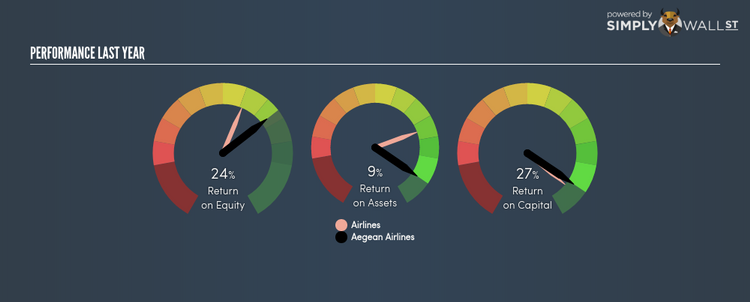Can Aegean Airlines SA. (ATH:AEGN) Continue To Outperform Its Industry?

Aegean Airlines SA. (ATSE:AEGN) outperformed the Airlines industry on the basis of its ROE – producing a higher 24.35% relative to the peer average of 19.64% over the past 12 months. While the impressive ratio tells us that AEGN has made significant profits from little equity capital, ROE doesn’t tell us if AEGN has borrowed debt to make this happen. In this article, we’ll closely examine some factors like financial leverage to evaluate the sustainability of AEGN’s ROE. See our latest analysis for Aegean Airlines
Breaking down Return on Equity
Return on Equity (ROE) weighs Aegean Airlines’s profit against the level of its shareholders’ equity. An ROE of 24.35% implies €0.24 returned on every €1 invested. Generally speaking, a higher ROE is preferred; however, there are other factors we must also consider before making any conclusions.
Return on Equity = Net Profit ÷ Shareholders Equity
ROE is assessed against cost of equity, which is measured using the Capital Asset Pricing Model (CAPM) – but let’s not dive into the details of that today. For now, let’s just look at the cost of equity number for Aegean Airlines, which is 8.85%. Since Aegean Airlines’s return covers its cost in excess of 15.50%, its use of equity capital is efficient and likely to be sustainable. Simply put, Aegean Airlines pays less for its capital than what it generates in return. ROE can be split up into three useful ratios: net profit margin, asset turnover, and financial leverage. This is called the Dupont Formula:
Dupont Formula
ROE = profit margin × asset turnover × financial leverage
ROE = (annual net profit ÷ sales) × (sales ÷ assets) × (assets ÷ shareholders’ equity)
ROE = annual net profit ÷ shareholders’ equity
The first component is profit margin, which measures how much of sales is retained after the company pays for all its expenses. Asset turnover shows how much revenue Aegean Airlines can generate with its current asset base. The most interesting ratio, and reflective of sustainability of its ROE, is financial leverage. Since ROE can be inflated by excessive debt, we need to examine Aegean Airlines’s debt-to-equity level. The debt-to-equity ratio currently stands at a low 12.75%, meaning the above-average ROE is due to its capacity to produce profit growth without a huge debt burden.
Next Steps:
While ROE is a relatively simple calculation, it can be broken down into different ratios, each telling a different story about the strengths and weaknesses of a company. Aegean Airlines’s above-industry ROE is encouraging, and is also in excess of its cost of equity. ROE is not likely to be inflated by excessive debt funding, giving shareholders more conviction in the sustainability of high returns. Although ROE can be a useful metric, it is only a small part of diligent research.
For Aegean Airlines, I’ve compiled three fundamental factors you should look at:
Financial Health: Does it have a healthy balance sheet? Take a look at our free balance sheet analysis with six simple checks on key factors like leverage and risk.
Valuation: What is Aegean Airlines worth today? Is the stock undervalued, even when its growth outlook is factored into its intrinsic value? The intrinsic value infographic in our free research report helps visualize whether Aegean Airlines is currently mispriced by the market.
Other High-Growth Alternatives : Are there other high-growth stocks you could be holding instead of Aegean Airlines? Explore our interactive list of stocks with large growth potential to get an idea of what else is out there you may be missing!
To help readers see pass the short term volatility of the financial market, we aim to bring you a long-term focused research analysis purely driven by fundamental data. Note that our analysis does not factor in the latest price sensitive company announcements.
The author is an independent contributor and at the time of publication had no position in the stocks mentioned.


